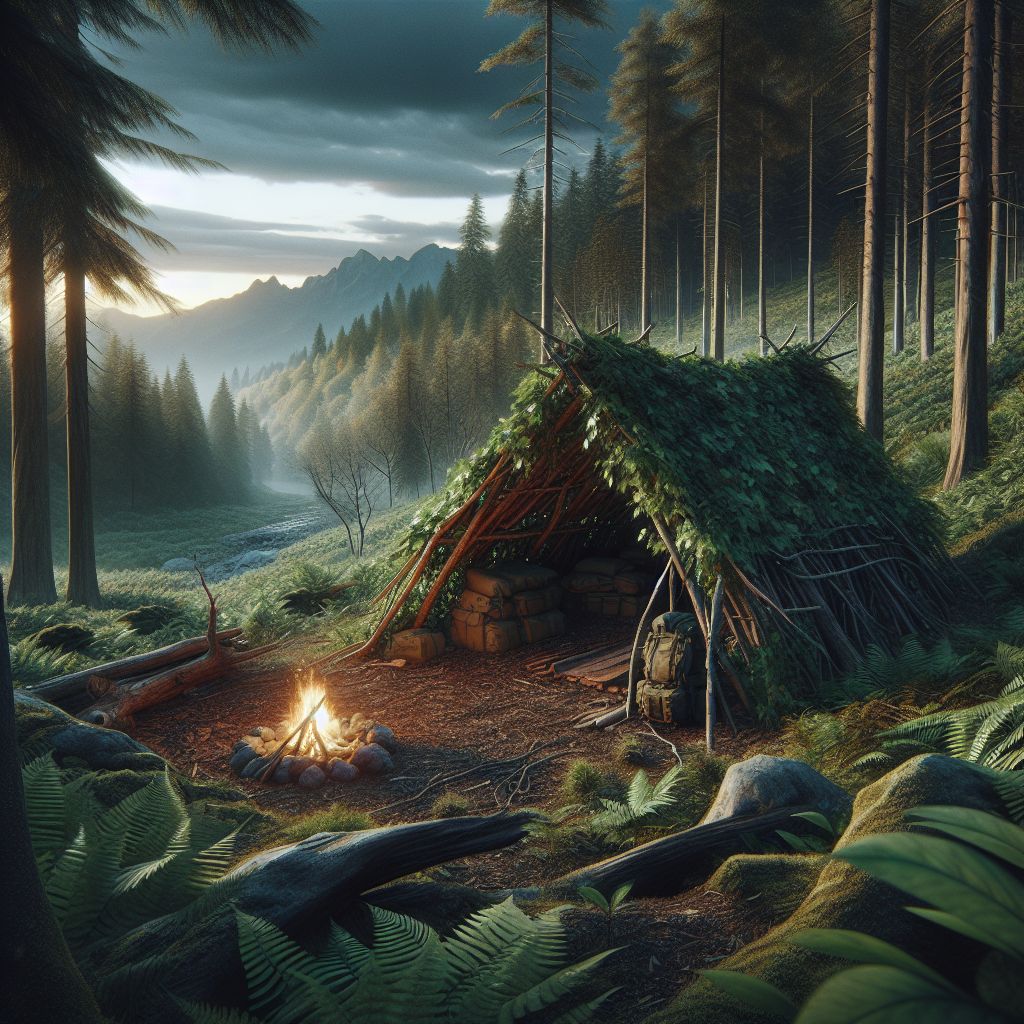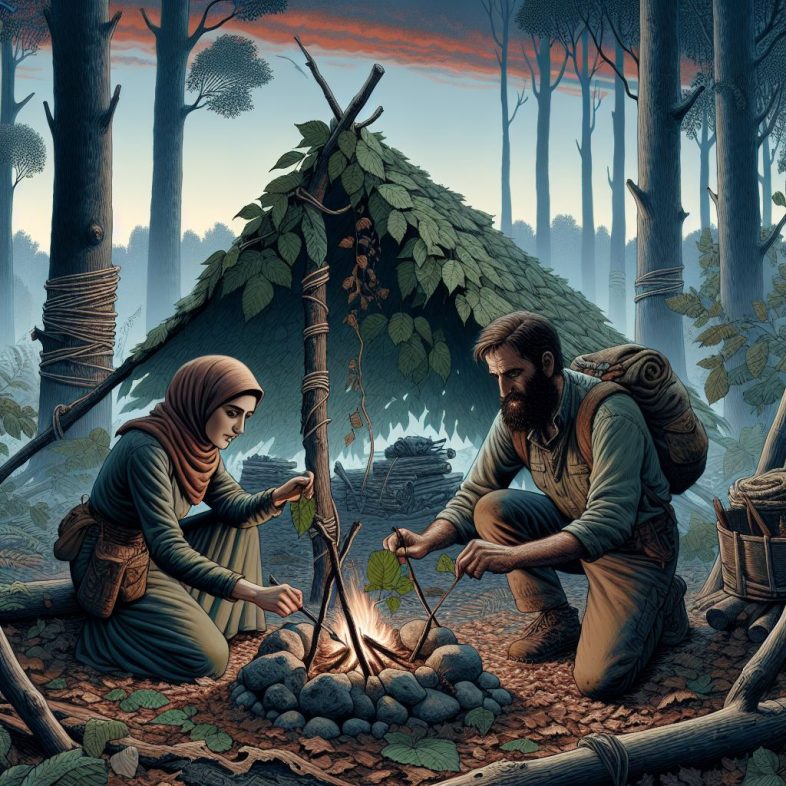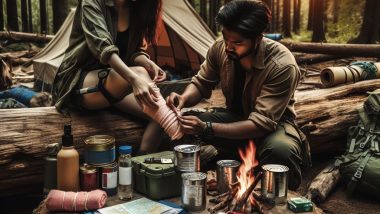Main Points
-
Honing your situational awareness is key to recognizing and avoiding potential dangers.
-
Knowing basic first aid can be a lifesaver in emergency situations.
-
Knowing how to locate and clean water is crucial for survival.
-
Being proficient in starting a fire ensures you can stay warm and cook food.
-
Emergency signaling is an important skill for getting help in remote areas.
1. Situational Awareness and Attitude
When it comes to survival, your brain is your most powerful tool. Situational awareness is the ability to recognize, process, and understand the key pieces of information about what’s happening in your environment. It’s not just about looking, but also understanding and predicting events before they happen.
Honing Your Instincts for Threat Detection
Picture yourself strolling through a forest. Suddenly, you hear the crack of a twig and immediately stop in your tracks. Is it a dangerous animal, or merely the breeze? The choice you make in that moment could mean the difference between life and death. To improve your ability to perceive your surroundings, follow these steps:
-
Take note of your environment without interruptions.
-
Listen more than you talk.
-
Trust your instincts when something doesn’t feel right.
Keep in mind, it’s not about being paranoid, it’s about being ready. By mastering this skill, you can avoid dangers before they become immediate threats.
Keeping Your Cool in High-Stress Situations
In any survival situation, the worst thing you can do is panic. The ability to keep your cool in high-stress situations comes from having confidence in your skills and knowing you’re prepared. Practice deep breathing exercises and keep a positive attitude. These techniques will help you stay focused and make rational decisions, even when things are at their worst.
2. Health Care Skills
Basic First Aid
Accidents can occur at any moment, and in a survival situation, immediate medical help may not be accessible. Having a basic understanding of first aid can mean the difference between life and death. Every prepper should know how to perform basic first aid.
-
Be able to cleanse and bandage wounds to avoid infection.
-
Know how to do CPR and the Heimlich maneuver.
-
Recognize and manage symptoms of typical sicknesses and injuries.
Think about enrolling in a certified first aid class to get practical training. And, above all, always have a fully equipped first aid kit on hand.
Dealing with Typical Injuries and Illnesses
Sprains, lacerations, and burns are injuries that are likely to happen in the wilderness. You need to know how to identify infection symptoms like redness, swelling, and heat around a wound. For sprains, keep in mind the RICE method: Rest, Ice, Compression, and Elevation. For burns, cool the affected area with running water and then cover it with a clean bandage. Discover more about survival and prepper books that can provide detailed guidance on handling such injuries.

3. Building a Shelter
Securing a safe place to stay is of utmost importance in any survival scenario. Being exposed to harsh weather conditions can result in life-threatening conditions such as hypothermia or heatstroke. A reliable shelter can also offer a feeling of safety and a space to relax and recuperate.
Choosing the Right Spot
The perfect spot for a shelter should be:
-
Level, so you’re safe and comfortable.
-
Near resources such as water and firewood, but not in a location that’s at risk of flooding or other natural disasters.
-
Hidden from possible dangers, whether they’re wildlife or humans.
Invest the time to select the best location. It could save your life.
Building a Shelter Using Natural Resources
Take advantage of what’s available in nature. You can use fallen branches, leaves, and even snow to build a temporary shelter. Always remember, insulation is important. The walls of your shelter should be thick enough to keep out the cold, or in hot environments, to reflect the sun’s heat.
4. Finding water
Water is essential to life. When you’re in a survival situation, it’s crucial to find a source of clean water. While you can survive for weeks without food, you can only last a few days without water.
Finding water in the Wilderness
Here’s how you can locate water: for detailed guidance, consider reading about essential survival skills which include finding water in challenging environments.
-
Search for indications of water in your surroundings, like lush greenery, bugs, or converging animal paths.
-
Gather rainwater or morning dew using clean fabrics or containers.
-
Get to know the terrain; valleys and depressions naturally accumulate water.
When you’ve located water, it’s vital to clean it to prevent diseases carried by water.
How to Purify water
Boiling is the surest way to make water safe to drink. If you can’t boil water, you can use purification tablets or filters. Another method is solar water disinfection, or SODIS, which uses sunlight to kill pathogens in clear plastic bottles. No matter what method you use, make sure the water is safe to drink.
5. Making Fire
Fire serves many purposes. It provides heat, cooks food, sterilizes water, and can be used as a distress signal. It was one of the first things we humans learned to control, and it’s just as vital now as it was then.
Getting Started with Flint and Steel
Flint and steel is one of the most dependable methods for starting a fire. Here’s how you do it:
-
Hit the flint with the steel at a sharp angle to generate sparks.
-
Guide the sparks towards a tinder bundle composed of dry, fibrous substance.
-
When the tinder ignites, blow softly to provide it oxygen and enhance the flame.
It takes training, but once you master it, you can light a fire in almost any situation.
Other Ways to Start a Fire
Flint and steel aren’t the only ways to start a fire. Other methods include:
-
Battery and steel wool: If you touch a battery’s terminals to steel wool, you’ll get a spark.
-
Bow drill: Rapidly spinning a piece of wood will create enough heat to start a fire.
-
Magnifying glass: You can ignite tinder by focusing sunlight onto a small point.
All these methods have their own benefits and difficulties, but the most important thing is to practice them before you actually need them.
6. Signaling in Emergencies
Knowing how to signal for help can save your life if you’re lost or in trouble. Always have a plan for how you’ll get someone’s attention if you need to be saved.
Signaling for Help
Visual signals can be anything from signal fires to wearing bright clothing to spelling out ‘SOS’ with rocks or logs. Audible signals can be as simple as blowing a whistle or banging on a metal object to make a loud noise. The goal is to make your signals so big, loud, or bright that they can’t be overlooked.
For instance, if you blow a whistle three times or set up three fires in a triangular formation, people around the world will recognize that you’re in trouble. Keep using your signal to boost the odds of someone noticing or hearing you. Learn more about essential survival skills to enhance your chances of rescue.
Modern vs. Traditional Signaling Techniques
Although conventional signaling techniques are still useful, you can also use modern options like personal locator beacons (PLBs) or satellite messengers. When turned on, these gadgets send a distress signal with your precise location to search and rescue teams.
So, always make sure to have a signaling device in your pack. It could be something as simple as a mirror for flashing sunlight or a high-tech PLB. It could be the difference between getting rescued quickly or not getting rescued at all.
7. Finding food
Scavenging for food in the wilderness is a skill that needs a lot of knowledge, patience, and practice. It’s crucial to know which plants and animals are safe to consume, as well as the best methods to collect and hunt them.
Safe-to-Eat Plants and Bugs
There are plenty of plants and bugs out there that can provide you with the nutrients you need to survive. However, not all of them are safe to eat, so knowing how to identify the ones that are is key:
-
Identify edible plants and bugs in a variety of settings.
-
Learn how the changing seasons can impact the availability of certain types of food.
-
If you’re unsure about a plant or bug, try a small amount first to prevent possible poisoning.
Survival Hunting and Trapping
Hunting and trapping for survival require a certain set of skills and understanding of how animals behave. Here are some tips:
When it comes to hunting:
-
Learn how to craft and operate a basic bow or slingshot.
-
Get to know the behavior of local wildlife and their habitats.
For setting up traps:
-
Setting up basic snares and deadfalls can be a good way to catch small animals.
-
Make sure to check your traps often to prevent the meat from spoiling.
Keep in mind, you want to get food while using as little energy as possible.
8. Navigational Know-How
It’s easy to lose your bearings, but if you’ve got good navigational skills, you’ll be able to find your way back to safety. These skills are important whether you’re in the middle of the wilderness or trying to find your way around a city.
Basics of Map Reading and Land Navigation
It’s critical for any prepper to know how to read a topographic map and use a compass. Here’s what you need to know:
-
Get comfortable with recognizing landmarks, contour lines, and other features on a map.
-
Make it a habit to take bearings and triangulate your location.
-
Always have a physical map and compass with you, as electronics may not always work.
Finding Your Way with the Stars and Sun
If technology lets you down, look to the sky. The sun rises in the east and sets in the west, which can help you figure out which way is which during the day. At night, if you’re in the Northern Hemisphere, you can find true north by locating the North Star (Polaris).

“Scouting Knots | Learn How to Tie …” from www.animatedknots.com and used with no modifications.
9. Tying Knots
Tying knots is a skill that can be useful in a variety of survival situations. Whether you’re setting up a shelter or securing your gear, knowing how to tie different types of knots can simplify things.
Key Knots That All Preppers Need to Master
There are numerous knots to learn, but here are some that are crucial: Discover more in this comprehensive survival and prepper books.
-
Bowline: This knot creates a loop that won’t slip or tighten.
-
Square Knot: This knot can be used to join two ropes of the same thickness.
-
Taut-Line Hitch: This is an adjustable knot that can be used for tensioning lines.
How Knots Can Be Used in Survival Situations
You can use knots for:
-
Constructing places of refuge.
-
Constructing fish-catching tools or traps.
-
Securing heavy burdens.
Practice these knots until they become second nature. This skill will come in handy. For more detailed guidance, check out our Ultimate Wilderness Survival Tips.
10. Predicting the Weather
Being able to read the weather is a key skill. It can help you prepare for a storm or take advantage of a nice day. It’s a critical skill for planning your day and staying safe.
Interpreting Weather Signs
Get a feel for the sky. The type of cloud, the wind’s direction, and sudden shifts in temperature can all suggest what kind of weather is coming.
Signs in Nature that Predict Weather Shifts
Plants and animals usually respond to environmental changes before we humans do. Here are some examples:
Ants tend to build their mounds taller before a heavy rain, and pine cones will open up when the air is dry, which usually means fair weather.
If you pay attention to these natural signs, you can often predict the weather more accurately than if you were using technology.
11. Surviving in the City
Survival isn’t just about making it in the wild; cities can be just as dangerous. In an urban environment, you need to know how to locate resources, navigate through crowds, and keep yourself safe from environmental hazards and other people.
Adapting and Locating Supplies
In a city environment, it’s crucial to adapt and not stand out. Search for supplies in areas that others may not think of, like:
-
Water from heaters or toilet tanks (only in desperate situations).
-
Food from deserted stores or dumpsters (be careful of rotten food).
Strategies for Escape and Evasion
If you need to navigate through a city without being seen, it’s crucial to know strategies for escape and evasion. Avoid main roads, try to move at night if you can, and always have a plan for quick escapes.
12. Planning for Disasters
Whether it’s a natural disaster or one caused by humans, you never know when disaster will strike. But if you have a plan, you and your family will be prepared and safe.
Designing a Custom Emergency Plan
Each family’s needs are unique, so your plan should reflect that. Consider becoming an urban prepper to tailor your emergency strategy to your specific urban environment.
-
Designated escape routes and gathering places.
-
How to communicate if you’re not together.
-
Considerations for family members with special needs, as well as pets.
Compiling Necessary Documents and Supplies
Store essential documents such as identification, insurance paperwork, and health records in a safe, easy-to-reach location. Your supply kit should contain:
-
Supplies for first aid.
-
Equipment and tools for self-reliance.
Make sure to frequently update your supplies and plan so that they’re always prepared for use when necessary.
Managing Fear and Anxiety
It’s only human to feel fear and anxiety when faced with a dangerous situation, but these feelings can be paralyzing in a survival situation. The trick is to recognize these feelings but not let them take over. Start by focusing on your breath; deep, slow breaths can help quiet your mind and lessen panic. Then, make a list of what needs to be done, breaking it down into small, doable steps. This can help create a feeling of control and accomplishment, which can lessen fear.
Another powerful tool is to visualize positive outcomes. Imagine yourself successfully navigating the situation with skill and serenity. This mental practice can increase your self-assuredness and lessen your worry. Keep in mind, fear is a response, survival is a choice.
Keeping Your Spirits High in Survival Scenarios
When you’re freezing, starving, and exhausted, it’s easy to lose motivation. However, maintaining your will to survive is crucial. Break your tasks down into manageable chunks and reward yourself for each one you complete. It’s also important to keep a positive mindset. Keep in mind what you’re struggling to get back to, whether it’s your loved ones, your buddies, or just your own cozy bed.
Moreover, sticking to a routine can give you a sense of normality and purpose. Set a daily schedule for activities like foraging for food, taking care of your shelter, and sending out signals for help. Keeping yourself occupied not only improves your survival odds but also helps keep your morale high.
17. Building a Community
Surviving is not only about personal abilities, it’s also about being part of a community. Establishing connections with people who share your mindset can lead to mutual help and can enhance your shared knowledge and resources.
Building a Network of Like-Minded Survivalists
Reach out to other survivalists by becoming a part of local survivalist groups or online forums. Trading stories and tips can be very helpful. You could pick up new techniques or find out about creative fixes for everyday issues. Also, in a disaster situation, it can be priceless to have a group of friends who can help.
Networking is not just about taking, it’s about giving. Be ready to learn from others and share your own expertise. It’s a reciprocal process that can foster powerful, mutually advantageous connections.
Creating a United and Collaborative Team
When you’re in a survival situation with a group, working together is key. You can create a united team by setting up clear lines of communication and assigning tasks based on what each person is good at. To make sure everyone knows what to do in a crisis, practice survival drills together regularly.
At the heart of any successful team is trust. Create a culture of dependability, truthfulness, and encouragement to build a space of shared admiration and teamwork.
18. Technical Know-How
In our modern era, technical know-how can be just as crucial as the old school survival skills. Knowing how to tap into alternative energy sources or communicate without the usual methods can give you a serious leg up in a survival situation.
Powering Your Home Off the Grid
When the power goes out, alternative power sources like solar panels, wind turbines, and hand-crank generators can keep the lights on. Get to know how these systems work, how to install them, and how to keep them running.
For example, a mobile solar charger can keep vital gadgets like torches and radios working. Getting to grips with these tools now ensures you won’t be caught unawares when you need them the most.
It’s also important to know the limitations of these technologies and have backup plans ready. For example, solar panels don’t work as well on cloudy days, so having a backup power source like a hand-crank generator can be a lifesaver.
Communicating Without the Usual Means
When disaster strikes, you can’t always rely on your cell phone or the internet. That’s where things like ham radio come in. They can give you a link to the outside world when you need it most. You should consider getting a ham radio license and learning how to use it as part of your survival plan.
Ham radios have the ability to reach contacts that are local or international, depending on the equipment and conditions. They can be used for gathering information, requesting help, and communicating with other survivors.
19. Staying in Shape
Being physically fit is a key survival skill. Your body is your most important tool, and keeping it in top shape will help you survive in tough situations.
Workouts to Improve Stamina and Power
Consistent workouts can improve the stamina and power necessary to transport gear, navigate tough landscapes, and manage the physical demands of survival. Concentrate on:
-
Heart-pumping exercises such as jogging, swimming, or biking.
-
Resistance training using bodyweight exercises or lifting weights.
-
Stretching exercises to avoid injuries and keep flexibility.
Even easy daily tasks like walking or using the stairs can add to your overall fitness. The aim is to be as physically ready as possible for any situation.
Health and Nutrition in Survival Situations
It’s just as important to understand nutrition and maintain your health as it is to stay physically fit. Your body will need the correct fuel to function effectively in a survival situation. You should learn about maintaining health and nutrition.
-
Understanding the nutritional value of wild edibles and how to add them to your meals.
-
Learning how to ration your food supply to keep up your energy levels over a long period of time.
-
Practicing basic hygiene to avoid getting sick.
By eating a balanced diet and drinking plenty of water, you can stay strong and healthy, even in the toughest of situations.
20. Skills for Sustainable Living
Survival is not just about getting through the next few days, it’s about creating a sustainable lifestyle for the long term. This means being able to produce your own food, manage waste, and use resources wisely.
Growing Your Own food
Knowing how to garden, raise animals, and forage for food can ensure you always have something to eat. You can start by learning how to grow vegetables in your backyard or even on your balcony. You’d be surprised at how much you can grow in a small space if you use the right techniques.
Keeping small livestock such as chickens or rabbits can be another way to get protein. Also, don’t forget about the potential of foraging; learn what edible plants and mushrooms grow near you.
Living Sustainably with Renewable Resources and Waste Management
Adopting renewable resources and proper waste management are key to a sustainable lifestyle. Composting your organic waste, collecting rainwater, and reusing materials can help you reduce your dependence on outside resources.
When you adopt these habits, you’re not just getting ready for possible survival situations, but also leading a more environmentally-friendly life.
Common Questions
If you’re interested in survival, you probably have a lot of questions about how to improve your skills and knowledge. Here are some answers to common questions:
What’s the Most Important Skill for a Prepper to Master?
The most important skill is adaptability, or being able to evaluate a situation and react appropriately. This includes everything from finding shelter and water to first aid and self-defense.
Where Should I Start in Mastering These Survival Skills?
Begin with the essentials: get to know how to construct a shelter, ignite a fire, and clean water. There’s a wealth of materials you can use, ranging from books and online classes to survival workshops in your area. Regular practice will help you become more confident and skilled.
Where Can I Find the Best Resources to Improve My Survival Skills?
Books, online discussion boards, and local survival groups are all great resources. Make sure to get your information from reliable sources who have hands-on experience. Remember, knowledge without application is like a book on a shelf – it only becomes useful when you open it and use it.
Can Everyday Life Benefit From Survival Skills?
Definitely. Skills such as being aware of your surroundings, knowing first aid, and being resourceful are useful in everyday life, not just in survival situations. They can help keep you safe, solve problems, and even help you save money.
How Can I Help My Family Learn These Crucial Survival Skills?
Get your family involved in your practice. Make it enjoyable and interesting, and concentrate on the practical aspects. Start with easy activities such as camping trips, which can provide basic skills in a relaxed environment. As they become more comfortable, incorporate more advanced strategies.


